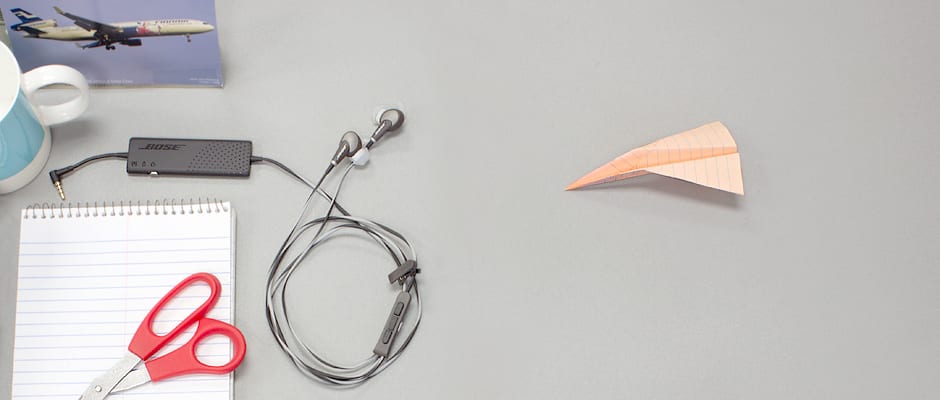Pros
Cons
Overview
The flip of a switch is all you need to quiet the commotion of the outside world, and the compact form factor makes the QC20i the perfect fit for your travel bag, too. The tradeoff? When your battery loses power, so does the A+ audio quality.
Design & Features
Designed with peace and quiet in mind
The QC20i's biggest claim to fame (and that fat price tag) is definitely active noise cancellation. Three hundred dollars is your ticket to silencing bawling babies, loquacious ladies, and yippie Yorkies. And that's not even the impressive part. These earbuds quell even the most powerful of outside noises—passing motorcycles, roaring city buses, and even jackhammers get reduced to mere whispers. I want to be clear: This noise cancellation is incredible. With the click of a button, my approaching train became little more than a soft whoosh. Just flip the switch and outside noise falls to as much as 1/16 its original loudness. Just take care: Dulling this much outside noise isn't safe for a solitary walk home.
So how does it work? Bose planted tiny microphones on the inside and outside of each speaker. When you activate the cancellation, these microphones measure the frequencies of the noises around you, and a processor compares those noises to what you're listening to (though the feature also works if you aren't listening to anything). The processor then sends a signal to your ear that reduces the outside sounds. That's why you feel a slight pressure in your ears when you turn this feature on—electrical signals are hard at work, moment by moment. You may find the pressure in your ears to be bothersome at first, but most acclimate soon enough.
{{photo_gallery "looks"}}
For the most part, the QC20i is a comfortable product. The silicone tips don't lodge fully into your ear canal, so you can wear them for hours without discomfort. Bose also packages three sets of the silicone covers in different sizes to help you find the right fit. Obviously the compact shape makes the QC20i great for on the run. Find the right-sized silicone speaker covers and make use of the shirt clip—you'll be free to enjoy a quiet ride to work with the added convenience of a four-button remote. Two buttons are for volume (up and down), one is for skipping/pausing songs and taking calls, and the fourth one tunes you back into the world so that you can hear your surroundings again without removing the earbuds.
The only other noteworthy design aspect is no doubt the cumbersome battery pack. The otherwise normal cable got whacked with an ugly stick at its base, so that you're stuck carrying a sizable, chocolate rectangle everywhere you go. For this reason, the QC20i probably isn't the right choice for athletes. At least when the bulky battery dies you can still listen to music. Bose includes a USB charger that juices the lithium-ion battery in two hours time. As for the battery life, the company claims it will last 16 hours.
Audio Quality
Top-notch results—until the battery dies.
The QC20i's overall soundscape is almost perfectly on-point. Unlike studio-grade headphones, these earbuds do place a fair amount of emphasis on the bass range, meaning the sound profile isn't as flat and dynamic as many purists require. Either way, listeners get distortion-free sound, unhampered by clipped acoustics and the like. Just keep that battery charged.
If you turn the active noise cancellation (ANC) off, or if your battery dies, a regrettable drop in volume occurs in the high midrange, impacting upper notes on beloved instruments like the guitar, certain horns, and percussion, to name a few. This drop in emphasis doesn't completely ruin the listening experience, and many listeners will never even notice it, but it's a detail that practiced ears are sure to resent. The drop in volume wouldn't be as problematic if it weren't for the prominent bass, but the combination of these two things results in an upper midrange that lacks the level of detail one might expect from a $300 set of headphones.
When you turn ANC on, sound quality improves. Volume doesn't drop in the upper midrange like before, so even with the prominent bass, music retains a fine level of detail. Essentially, when ANC is on, listeners who prefer bass-driven sound—accented by delicate upper midrange details—will fall in love with the QC20i.
Last Word
Powerful isolators with winning sound quality
The QC20i (MSRP $299.95) earbuds may not have the best audio quality on the block... but they can silence the entire block. If you don't mind a bass-forward soundscape, and if the slight pressure that occurs in the ears as a result of active noise cancellation doesn't bother you, you'll likely find a great friend in these Bose earbuds. If a firm foundation in bass doesn't suit you, then the QC20i won't be your cup of tea.
Many of us just need some peace and quiet, and the QC20i is very formidable in that regard. Maybe you fly a lot, which makes you nervous. Zooming around the sky in a metal tube just doesn't feel right, and screaming infant twins in aisle 6 make matters worse. Maybe your bathroom is getting remodeled. Whatever the noisy case might be, the QC20i can fight the madness—with Jedi-like strength. Many in-ears can hush the high-pitched noises of the world, but the QC20i can handle the booming roars of a train crashing down its tracks. For that reason, the QC20i seems well worth its weighty price.
Number Drop
Don't let the QC20i's small form factor fool you: They may be little, but these earbuds pack some serious performance. Faced with our audio lab and our judgmental robot, these Bose headphones passed tests with flying colors again and again. The frequency response is nicely balanced, the distortion is low, and the noise blocking is nothing short of admirable. Read on for more details about each of these performance aspects.
Noise Reduction
Behold the golden silence.
Push a button and enjoy the unexpected hush of the QC20i earbuds. It's shocking. Don't use this feature if you're walking home alone or biking in traffic—talk about a big, deaf sitting duck! In-ears are inherently good at blocking outside noise—they fill your entire ear canal, after all—but most headphones fail to quell powerful low-frequency noises. Not so with the QC20i: I literally couldn't hear a man with a jackhammer on my way to work the other morning. All told, the QC20i reduces noise to as much as 1/16 the original loudness.

Frequency Response
A balanced set of Bose
Purists, feel free to turn your noses up at this far-from-flat frequency response. Everyone else, this is likely right up your bass-bumping alley. In manner of an equal loudness curve, which makes every note equally loud to the human ear, the QC20i earbuds produce very balanced sound—but only when the active noise cancellation is on. Bass booms, but lighter, more delicate instruments hold their own too. Thus, the overall soundscape is bass driven, but still detailed and dynamic.

If you turn the active noise cancellation off, you're stuck with a horse of a different color. The sound profile carries the same bass-forward balance, but high mids of 2kHz to 4kHz tumble down in volume by as much as 8.5dB—unpracticed ears may never hear it, but purists will dislike this very much. Because of this drop in volume, upper middle notes on various stringed instruments, brass, and percussion lose proper emphasis. Coupled with the bass-heavy foundation, this makes for rather indelicate sound at times.

Distortion
Barely a drop
With or without the active noise cancellation activated, listeners won't be bothered by distortion on the QC20i. Levels are so low as to be inaudible, and with cancellation, even the sub-bass range is largely distortion-free. Until you turn your music up past the ill-advised level of 102.077dB, distortion keeps below 3%.

And without active noise cancellation:

Looking Further...
{{photo_gallery "other"}}
Meet the tester
Virginia is a former Managing Editor at Reviewed.com. She has a background in English and journalism. Away from the office, Virginia passes time with dusty books & house cats.
Checking our work.
Our team is here to help you buy the best stuff and love what you own. Our writers, editors, and experts obsess over the products we cover to make sure you're confident and satisfied. Have a different opinion about something we recommend? Email us and we'll compare notes.
Shoot us an email


